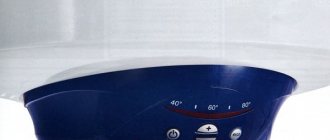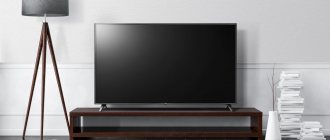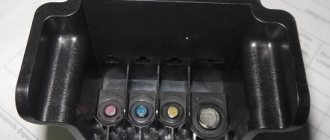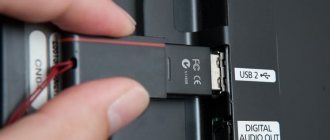A TV is a frequently used device that is found in almost every home. The more the equipment works, the more likely it is to fail. Many problems can arise. But, before taking the TV to a repairman, you need to make sure that the problem exists at all, and if so, what it is. It is quite possible that you can repair your TV yourself at home.
Troubleshooting algorithm
To find the answer to how to repair a TV, you need to understand what the problem is. Identifying faults will help both for independent TV repair and for a service center. In the second case, you will be able to explain to the technician the reason for the breakdown of the television device, which will speed up the process of solving it.
Below is a description of the main malfunctions that occur when the TV breaks down:
- I can't turn off the device. It doesn’t matter: whether it’s a CRT TV or a modern LCD TV, there is only one reason - the fuse has blown. It just acts as different parts in different devices. It is also possible that the diode bridge does not work.
- In both domestic and imported TVs, the potential for which the posistor is responsible may be lost.
- The plasma is broken. This may manifest itself in changes in the color rendering of the television broadcast, differences, interference, and the appearance of light or dark stripes.
- The power cord is broken or the socket is faulty.
If you decide to find the problem yourself, you will first have to clean the internal elements from dust, using a soft brush or vacuum cleaner. Sometimes you can visually determine the location of the malfunction by changing the color of components or their deformation. If such an inspection does not produce results, you will have to look in specific circuits and devices: power supply, picture tube, video amplifier, etc.
What is a plasma screen?
Plasma screen TVs appeared much earlier than most of us are used to thinking - more than fifty years ago. True, their appearance and characteristics were far from modern. Today, they not only do an excellent job with their main function - image transmission, but are also an excellent stylish addition to the interior of rooms - both residential and office. They can be easily installed on a table using a special stand, and can also be easily mounted on a wall.
Plasma is considered the most optimal option for watching dynamic scenes in movies, broadcasting sports games and bright cartoons with 3D technology.
Important! It is these screens that have the highest color rendering quality, brightness and contrast, black depth display, as well as the widest viewing angles.
What is this modern miracle of technology?
The structure and principle of operation of a plasma screen
The basis of a plasma display is a matrix, which consists of a large number of sealed cells filled with a special mixture of xenon and neon, and coated with phosphors. Conductors are located along the entire perimeter of the matrix. An electric discharge passes through the gaseous medium and creates an ultraviolet glow, which contributes to the glow of the phosphors. As a result of this action, each cell lights up with the required color, and together they create a picture that the viewer sees on the screen.
The entire structure is limited on both sides by planes (most often glass). If in the first models of plasma displays the glass thickness was 3 mm, then the latest screens have thinner planes - only 2 mm. This move reduced the weight of the equipment, but at the same time led to greater sensitivity of the TV to mechanical damage. The fragility of the screen has increased significantly.
Important! Remember that any household appliance can become unusable due to the banal reason of failures and power surges. To protect yourself, be sure to read about surge protectors and choose the right one for you.
Repair of plasma and LCD TVs
Before you begin repairing LCD or LED TVs, you should carefully read the documentation for the device and study the operating principle of your model.
When repairing plasma TVs yourself, you must take utmost care to avoid deteriorating the condition of the unit. In liquid crystal (LSD) television receivers, the backlight is produced by fluorescent or fluorescent lamps, and in LED televisions, LEDs are used. Repair of imported LCD TVs Samsung, Sharp, Thomson, Panasonic is similar. Therefore, the procedure for their repair is the same, and it is as follows:
- If you cannot turn on the monitor, then the first thing to do is check whether the backlight is supplied with power.
- Unplug the unit from the outlet.
- Regardless of the TV brand, you need to remove the back panel by unscrewing the screws.
- Next, remove the mains power wires from the matrix.
- To check the functionality of the wires, we connect an ordinary 100-watt incandescent lamp to the contacts.
- Modern TVs often have several backlight sources, and therefore it is necessary to check each of them.
- When testing, the matrix is completely removed, the lamp is connected to the contacts, and the power cord is connected to the network.
- If the lamp is on, the wire is working; if not, it is necessary to replace the cable or repair individual threads.
What is the cause of LCD TV malfunctions?
The only problem is that there is no power; to check this on the LCD TV, you can do the following with your own hands:
- open the back cover of the model;
- remove the wires connected to the matrix;
- connect the working lamp to the contacts;
- There are also LCD models that provide more than one light source. In this case, it is necessary to test all sources. Just dismantle the matrix and connect your TV to the network - you can see which LED is the problem.
When a broken lamp in an LED or LCD TV is identified, it must be replaced. This stage requires maximum accuracy from the master, as well as special attention. In some cases, the lamp can be removed without removing the matrix; you just need to move the protective elements with the rubber gasket and pull out the lamp using a soldering iron. In a similar way, you need to install a working light bulb. Now we can congratulate you - you have repaired your LCD TV yourself! Just pay attention to one important nuance - the new light bulb must fully meet the parameters and dimensions of the broken one!
To repair TVs yourself, look carefully at the matrix! If there are “unhealthy” stripes here, then the breakdown lies in the matrix. Have a new part? Then everything is simple! You change it and turn on the TV, if it works, then you have accurately identified the problem.
If the reason for the breakdown of LCD TVs is the screen, then it is best to purchase new models of LCD or LED equipment. It is not recommended to change the screen of LCD and LED models, as this is impractical! This also applies to the LCD matrix.
What could be the problem with plasma TVs malfunctioning?
If you need to repair plasma TVs, then follow the same procedure as described above. Just adapt it to your specific case. This description can be applied to any model of plasma TV, just stock up on the necessary tools in advance. See also -
How to choose a TV for your home in 2021?
CRT screens
The beginning of repairing an LG TV with your own hands, as well as TV brands such as Panasonic, Samsung, Rubin, Sharp, etc., consists of checking the fuse.
In order to repair televisions with a cathode ray tube, it is necessary to check for the presence of basic faults, and then eliminate them.
Checking the fuse. To do this, unscrew the back panel, under which the board is located. The fuse is connected to the power terminals, which must be switched to the base of a regular lamp and connect the TV to the network. If the lamp goes out, it means the device is functioning properly. If the lamp did not start to burn or, on the contrary, was on all the time, then it is worth concluding that the fuse has blown.
Diode bridge. In the event of this breakdown, repair is possible only after dialing. To do this, you will need a multimeter and a TV passport, which indicates its main characteristics. And then you need to act according to the diagram given in the passport, although if the diode bridge breaks down, it is still better to take it to a service center.
The most difficult problem with CRT television receivers, as a rule, is a faulty posistor. To check it, you need to turn off and on the power circuit and monitor the working lamp. To carry out repairs, you will first need to adjust the network resistance, and then replace the posistor.
Capacitors or transistors have burned out. It is not difficult to detect them, this can even be done visually: if they are swollen or changed color on the board, then there is a problem. In this situation, the damaged part must be replaced.
Do-it-yourself CRT (picture tube) TV repair
Television receivers confidently occupy one of the leading places in use among other household appliances. They are used by all family members, both for educational purposes and for entertainment. One family may have several televisions. In the living room, kitchen, bedroom and so on.
The popularity of these devices is explained by the presence of a large screen, which, compared to monitors, provides more comfortable viewing of video content.
In addition, not everyone loves and knows how to use a computer, especially older people. Therefore, with the advent of the Internet, televisions still remain popular among different ages and segments of the population.
Like any household appliance, televisions break down sooner or later. Therefore, it would be useful to know the causes of breakdowns of these devices in order to prevent them, and if this does happen, try to repair the device yourself.
I would like to note right away that a TV is a very complex and fragile household appliance. It should be handled very carefully. This is due to the fact that it has a picture tube or liquid crystal panel, which can be damaged if handled carelessly and then replacing them can cost 70% of the cost of the TV itself. Therefore, you need to be extremely careful with them.
As mentioned above, there are two main types of TV screens. This is an electron beam tube (CRT or kinescope) and a liquid crystal panel.
Rice. 1. CRT TV, which I will repair
A ray tube is essentially a large vacuum tube, inside of which there is a vacuum and in which the beam draws an image using deflecting horizontal and vertical coils. Due to the fact that it has an elongated shape, the thickness of the TV is quite significant.
Liquid crystal panels lack all this. The panel itself is a set of LEDs of three primary colors and located next to each other.
The image is obtained by applying voltage to each LED from the video processor and, depending on its value, different colors and shades are formed on the screen. The use of liquid crystal panels has significantly reduced the thickness, weight, and power consumption of such televisions.
We can say that these are completely different devices in design. The only thing they may have in common is the receiving part, the circuit responsible for sound and controls.
In this article we will talk about repairing a TV with a cathode ray tube or picture tube, since they are still actively used, and there is a better chance of repairing such a device than a liquid crystal one.
But when repairing such devices, you need to be very careful, since they contain high voltage up to 25 thousand volts, which are necessary for the operation of the kinescope. This is indicated by the warning signs affixed to the inside of the kinescope. This voltage may remain on the handset even after the TV is unplugged.
Therefore, you should be careful and attentive so as not to receive a life-threatening electric shock. But more on that a little later.
Let's look at the “symptoms” of a breakdown of the Rolsen TV model C29R70T.
It is worth noting that this receiver is assembled from components from Samsung and Philips, which indicates a similar circuit design for other TVs of this type. This means that both the causes and the repair of devices from other companies will be carried out using the same method as here.
And so, let's move on to the breakdown itself, namely, how it manifests itself (see Figure 2). At first the TV worked fine, but periodically the image disappeared, the screen turned black, and there was a white horizontal stripe in the middle. However, sound, remote control and other functions worked fine.
Rice. 2. White horizontal stripe on the CRT TV screen
Also, no extraneous sounds in the form of crackling or burning odors were observed.
Over time, the image disappeared completely, and instead of it, there was always a light stripe in the middle of the screen. It is noteworthy that if you tap on the body of the TV, the band expands abruptly, synchronously with the blows.
Everything indicated that there was no good contact somewhere. Now I had to find where.
It is very important to identify a possible breakdown by “symptoms” in order to limit the search area and not waste time on the working components of the TV. Moreover, unnecessary disassembly, rotation of the board and removal of connectors can lead to even greater problems than before.
For example, some wire may break, and there is also a danger of “destroying” one of the fragile radio components on the board with your hands or a screwdriver.
Therefore, it is very important to carry out a preliminary diagnosis whenever possible.
Whatever it is, the TV will still have to be disassembled. Therefore, we proceed to dismantling the rear protective cover.
To determine where the fastening screws are located, you need to carefully inspect the cover from all sides. The screws may be so hidden that you may not notice them right away. And one unscrewed screw will prevent the lid from coming off, and in doing so, you can break the attachment point.
Rice. 3. Unscrew the fastening screws
When moving or turning the TV, do not shake or hit it too much. This can lead to a break in the filament in the kinescope bulb, which will lead to its failure and there is no point in repairing the device further. Of course, with a cold spiral this happens extremely rarely, but sometimes it happens.
So, the screws have been found, all that remains is to unscrew them. As you can see, the screws may be in hidden places.
Rice. 4. Unscrew the screw in a hidden place
One of the most inconvenient was in the lower part, under the TV. To get to it, you need to lift the back of the case and unscrew the screw. It is better to do this together, so that one person holds the TV, and the other person unscrews the screw.
The fact is that the front part, where the kinescope is, weighs three times more than the back. Therefore, when you try to tilt the TV from behind alone, it may tumble forward so that you do not have time to do anything.
If you still haven’t found a partner, then you can put several heavy books in front. This will give the TV a rest when trying to tilt it.
Rice. 5. Screw at the bottom of the TV
When all the screws around the perimeter of the cover are unscrewed, we try to pull it back. To make it come out of the grooves better, the TV needs to be tilted slightly forward.
Rice. 6. Pull off the TV cover
When removing the cover, make sure that it does not change its direction of movement. If it is sharply pulled to the side, it can break the kinescope bulb on which the board with the elements is installed.
Rice. 7. Fig. 8. We get access to the kinescope
The flask in this place is very fragile and has a significant narrowing. Also, when the lid is already removed, you need to be careful not to hit or snag this flask.
Rice. 9. CRT TV bulb
There is no need to touch or move the beam deflection adjustment levers, otherwise the image may not be clear later, and it will not be possible to return them to their original position without special devices.
Remove the lid and put it aside. When viewed with the naked eye, you can see how much dust is inside, both on the case and on the boards. If possible, it should be wiped off. Such dust becomes conductive and can cause short circuits and even fire.
Rice.
10. Wipe off the dust Due to the high voltage inside, all the dust from the room is attracted and settles near the elements of the high voltage converter.
Rice. 11. Dust inside the TV
Over time, current may shoot through it into the TV chassis. Therefore, dust must be removed. Even the manufacturers themselves recommend doing this at least once a year.
Take a rag and wipe the body both outside and inside.
You can see how much dust has accumulated on the surface over a couple of years of work.
Rice. 12. Dust on the surface of the board
It is also advisable to clean the board (see Figure 13). But not with a damp cloth, but with cotton wool soaked in alcohol.
When the cotton wool becomes dirty, it needs to be changed. This can also be done with a vacuum cleaner with a special brush attachment. In any case, you need to clean the boards carefully and slowly so as not to break anything.
Without dust, the board will cool better, which will prolong the life of its components.
Rice. 13. Cleaning the board from dust
Let's move on to troubleshooting. It is necessary to inspect the main board for burnt tracks and electronic components. To understand where to look for a fault, you need to know what conventional blocks the “stuffing” of the TV consists of, and which components are responsible for what.
The latest models of CRT televisions are built on a single-chip processor. These are mainly chips from Philips. The signal from the antenna input goes to the channel selector, where it is converted.
Rice. 14. Single-chip processor TDA9351PS/N3/1/1758
Next, the signal, after passing through some filters, arrives at this single-chip processor. Signals from the “tulip” and Scart connectors also come there.
Rice. 15. TV selector KS-H-148
It is processed and divided into audio, video signals and pulses necessary for the operation of the kinescope scan. Each signal comes out from a specific processor pin.
Further, it is either amplified using special microcircuits, or goes directly to the actuator.
The following signals can be amplified: low frequency (sound), video signal, vertical and horizontal scanning pulses. Each signal has its own amplifier, most often built on a microcircuit. Therefore, it’s a good idea to have a schematic diagram of a TV, which can be found on the Internet.
Rice. 16. Electronic filling of the TV board
Using Yandex search, you can determine which microcircuit is responsible for what.
This will make it easier to find the cause of the breakdown, paying special attention to the components of the corresponding unit.
Let's go back to our TV. Let's do a fault analysis. There is sound, the channels are switched, which means: the power supply, tuner, processor and sound amplifier are in order.
Please note that there is a horizontal stripe in the center on the screen. This indicates that the vertical scan is not working properly.
If the strip were vertical, attention would need to be paid to the horizontal scanning elements and the high-voltage transformer.
And so, the problem is the small amplitude of the vertical scanning signal. This signal is too small to sufficiently deflect the electron beam by the frame coils.
This means that the problem is most likely in the amplifier of this signal. Using a circuit found on the Internet for this TV, it was determined that this is a TDA8359J chip. It has nine pins and is located on a common radiator - heat sink.
On the board it is designated as D600.
Rice. 17.
Rice. 18.
Rice. 19. TDA8359J chip (D600 on board)
Perhaps it has failed, or its wiring - resistors and capacitors. We carefully inspect the microcircuit itself and nearby elements for discoloration or swelling. Nothing like this is visible.
Next, pull the board closer and turn it over. The traces and soldering points are visible here. For a good result, it is advisable to use a table lamp and a magnifying glass.
Rice. 20. Board on the reverse side
Also, you should be careful not to touch the solder joints of the high-voltage electrolytic capacitor, so as not to get discharged.
You can short-circuit the terminals of the capacitor with a screwdriver to remove the charge and work quietly.
Upon careful examination, through a magnifying glass, of the soldering joints of the legs of the D600 microcircuit, a defect was found in the form of a tin crack around the pin of the microcircuit (see Figure 21). It is very difficult to notice, especially with the naked eye.
Rice. 21. Place for soldering the legs of the D600 microcircuit
This defect is very common in various techniques. The reasons are: low quality tin, thickened legs of the part and significant heating during operation. It’s not for nothing that this chip has a heat sink.
Another reason may be vibrations and the thin fiberglass from which the board is made. The manufacturer saved on the thickness of the material, but in the end we have this problem. The board really bends easily, which leads to solder cracks, peeling of tracks and other defects.
The way out of this situation is to carefully solder all the legs of the microcircuit. Be sure to use flux when soldering. Do not use acid under any circumstances, but only rosin.
You can solder the legs of other power microcircuits and massive components.
Soldering processor pins unnecessarily is not recommended. Since they are too close, they can easily overheat, or the legs can be shorted together. Then it will be very difficult to get everything back.
After soldering, use a knife or something sharp to remove possible microconnections between the board tracks, especially where the work was done.
We install the board back and try to turn on the TV. It is advisable to put on the cover, taking care not to damage the kinescope, while holding the Scart connector from behind so that the board fits into the seats.
Rice. 22. Install the board back
As you can see in the photo, the picture expanded to the full height of the screen and this means that the problem was precisely in the cracks in the solder legs of the vertical scanning chip.
Rice. 23. The picture is displayed well, the TV works!
Now you can screw the cover on and continue using the TV.
Power supply repair
If the LCD TV cannot be turned on and there is no indication at the same time (or it turns on only for a certain time and then turns off on its own), then the problem is most likely in the power supply.
The Samsung TV repair scheme described below can be applied to all LCD TVs:
- Open the back panel of the device using a screwdriver.
- Remove the cover. The power supply will be located on the left side, and the motherboard on the right.
- The power supply board has upper and lower transformers. We begin the check with the last one listed, since it is responsible for the standby mode.
- The transformer we need must produce a voltage of 5 V. To measure the voltage, you need to find a wire. To do this, look at the marking or diagram: the required wire will be marked “5 V”.
- First you need to measure the open circuit. To do this, you need to connect one probe to the found contact, and the second to the diode cathode (located on the radiator). We set it to ring: if there is a sound signal, it means there is no break.
- After this, one probe of the multimeter must be connected to the TV panel, and the second one must be left in the same location. We turn on the screen to the network and begin the process of measuring voltage. If the device shows voltages less than 5 V, it means that the TV is not operating at full power and most likely the capacitor has dried out.
- We resolder the elements that have failed. To do this, you first need to remove the board and disconnect the matrix cable.
- We install the block back and assemble the device. After this the screen should work.
In order to properly assemble the TV and not get confused about where and what part should be located, you can first photograph the location of the parts.
Why the screen may be faulty
Before you start repairing, you need to determine what exactly caused the malfunction.
Here are the most common TV screen problems:
- Inability to turn on the screen. This problem is typical for any TV model. If the TV does not turn on, you can repair it by replacing the fuse.
- A blown fuse is the most common cause of screen problems. The main thing is to choose the right part. In addition to the fuse, the cause may be the power supply, wires, bridge and diodes.
- The picture is poorly lit. This problem is common with LCD screens. This requires backlight repair, which you can do yourself. It is enough to replace the diodes or directly adjust the backlight level.
- No sound. Every master knows what to do if the TV has no sound. Here you will need to replace the chip or speaker.
- There is a backlight, but the image is not visible. If this problem occurs, it is worth checking the video processor and signal receiving unit.
The most important thing during repairs is a complete inspection of all components. A burnt or failed part may cause a short circuit that must be corrected, otherwise new parts will also burn out.
Replacing the backlight
Another reason why the TV screen does not turn on may be a malfunction of the screen backlight lamp. To fix this problem you need to:
- Remove the back panel of the device using a screwdriver.
- The cables should be disconnected from the matrix, and the control panels from the case.
- Remove the housing with electronic boards.
- Unscrew the front panel, then remove the matrix and filters by unclipping the fasteners on the side.
- Turn on the power and hold down a couple of keys to enter the service menu. Thanks to this, the lamps will turn on for a certain time.
- Disconnect the lamp that does not light and replace it with a new one.
- Put all the elements back together.
- Turn on the TV receiver and go to the service menu again. Reset the lamp error counter.
- After this, the unit should function normally.
The LCD/LCD or plasma screen does not light up – there is an image, but it’s barely noticeable
This indicates a problem in the backlight circuit. There are two reasons for this:
- Fixtures (lamps or LEDs) are damaged.
- There is no power supply to the backlight (backlight generator, transformer, transistors).
If the LCD has a lamp backlight, then the rest have LED backlight.
First option
LCD devices have from 1 to 10 lamps. Rarely do all the lamps burn out at once. In the first case, the lamp itself may be faulty. As a rule, TV sets with other technologies have LED strips installed. In many models they are located in series, and the combustion of one of the LEDs leads to the extinguishing of the entire screen.
Repair of LCD and other TVs is performed as follows:
Step 1 . Open the case.
Step 2 . Remove the driver and power supply boards (they can be located in a metal casing).
Step 3 . Disassemble the screen part. To do this, you need to remove one or two metal casings and (if any) the protective film.
Step 4 . Find backlights or LED strips.
Step 5 . Replace those that do not light up. It doesn’t hurt to check the contacts in the lamps or the diode strip for breaks first visually and with a tester.
Second option
If you have the second case, and all the lights do not light, most likely the problem is in the backlight power supply. LCD equipment uses a high-voltage converter made according to a transformer circuit. Faulty parts (microcircuit or transistors) in its trigger circuit are easily determined by the tester. To do this, measure the voltage on their legs, checking the diagram. If a discrepancy is found, the element is replaced.
But the transformer is difficult to check. Check all voltages (according to the diagram) on the elements of this converter. If everything is normal, the transformer is to blame.
It can be rewound, but this is a hassle, and the quality of such winding will again lead to failure. It’s better to buy a new one (get a working one from a TV workshop) and install it.
In the LED backlight transformer, the potential difference is only 50-100 V. If it is not on the connector, you need to check how many volts are supplied to the transformer. To do this, it is better to remove it. If everything is normal, change the transformer; if not, use a tester to check the remaining elements of the converter.
Not working remote control
Before you start repairing your TV yourself, you should check whether the batteries are working from the remote control. If they shrink, they need to be replaced.
Dirty contacts under the buttons. To fix this problem, you need to disassemble the remote control yourself and wipe the contacts, then put the remote control back together.
The quartz emitter is damaged. This could happen if the remote control was dropped. This means that it simply needs to be replaced, since in this situation the emitter cannot be repaired.
Liquid has spilled onto the remote control, or it is completely flooded with water. To fix the problem, you need to disassemble and dry the remote control. If after this the remote control does not start working, then you need to replace it.
How to properly repair a TV
They forgot to give general instructions on TV repair. The main board is dismantled for convenience; you leave the chance of getting an electric shock even with the device turned off. It seems that no one has died yet; they received burns. You will need to discharge the cathode ray tube electrode. It is located under the rubber gasket. Without touching the metal parts with your hands, pry the rubber with a screwdriver, rocking it from side to side, and remove the electrode. Discharge the rod onto the body. If you see a ground loop nearby, it’s better to go to it. It is clear that for a successful procedure you need to have a Euro socket with correctly connected terminals on hand.
When discharged, clicking sounds will be heard. Continue touching the contact while the phenomenon is observed. On any modern TV, the electronics are assembled into one board that controls the operation. We will evaluate many radioelements visually for integrity. Damaged capacitors swell, resistors (active elements) turn black. Darkened resistance sometimes remains usable. The defect clearly indicates: the radio element closes the circuit of the broken element.
No TV signal
If there is no image on the screen, then the reason may be simple - there is no TV signal. This happens because the noise reduction protection is triggered and the device switches to standby mode. You can try to solve the problem yourself and wake up the TV from standby mode. If this does not work, then repairing the TV yourself is not advisable; it is better to take it to a specialist.
Thus, the decision to independently repair a television device must be made after assessing the level of your knowledge and skills in this matter. If you feel unsure of completing the task, it is better to contact the service center specialists.
The screen lights up, but there is no image
This happens for many reasons. Here are some of them:
There is no signal from the receiving unit (tuner and its circuits) to the input of the video amplifier . To check, you need to connect some video signal source (computer, VCR, set-top box) to the “Video” sockets on the TV body. For example, HDMI, VGA, tulips (yellow) and others.
If the image appears, the tuner, microcontroller and their circuits are to blame. The microcontroller can be checked quickly. It is responsible for the operation of buttons, input, sound and video signals. If when you press the buttons you can enter the menu and it is displayed on the screen, then the microcontroller is not at fault. Check the potentials on its legs with a tester. If they all match the diagram, change the tuner.
The video processor is to blame . If nothing happens after connecting to the tuners, then check the microcircuit (video processor). Check all supply and output circuits for compliance with the required potentials. If there is a discrepancy, the processor is 70% faulty.
Main nodes
A modern TV is a rather complex, high-tech thing that is not easy to repair and requires your skills: knowledge of circuit design, the ability to solder, handle all kinds of tools and understand the operating principles of this device and its individual components.
There are not many main components, but they are quite large and in fact are separate devices that interact with each other.
Main components of LCD TVs:
- TV power supply: this is in fact the heart of any electrical appliance. Serves to provide all components of the TV with the required currents, with specified voltages.
- TV inverter: this part converts low voltages from the power supply into high voltages satisfactory for heating the lamps and maintaining their uniform illumination of the backlight.
- Main board : This unit is one of the most difficult to repair.
It contains everything to control the remaining components of the TV, so it can also be divided into several components:
- CPU is a central processing unit used to receive signals, process them and send signals to subordinate devices. This can be anything up to specialized nodes, such as an audio scan processor, video processor or other complex node.
- The matrix is where the image is actually built.
- Timing Controller – converts signals from the main board to the matrix, thereby building the image on the matrix in the form in which we are already accustomed to seeing.
Fault calculation
When you try to turn on the TV box, it just shows you the black “Malevich square”. Don't rush to send it for recycling. A defect, malfunction or breakdown can be of any part on the TV; during diagnostics, you may discover that the photo matrix is faulty or deformed. And this may also be one of the reasons for the appearance of spots on the screen display or the disappearance of the image completely.
And also on the Elgie TV there was sound, there was an image, and then it disappeared. A malfunction that is associated with the failure of the ice-backlight.
LED TVs differ from other representatives in that the backlight is arranged sequentially. And if one stops working, burns out or is faulty, then the entire circuit will not function. In total, there are 2 main reasons why LEDs do not work: driver failure or LED failure.
How to determine the exact fault is very simple. We measure the driver voltage; if there is no response and the voltage does not change, then no voltage is supplied to the LED circuit. Here the driver definitely needs to be replaced. But if the driver voltage fluctuates from 130-200 volts. This indicates only one thing. The driver is attempting to brighten the screen. In this situation, the reason is the LED and it needs to be replaced. We measure the voltage with a special tool called a multimeter.
So, an important point, each LED TV manufacturer sets its own number of rows of LED backlighting; they range from 3 to 6, and sometimes up to 9. To determine which link in the LED chain is not working, we diagnose each one. After we managed to determine the right link. Let's move on to checking each LED. To do this, we supply a 3 V power supply to determine which LED is faulty.
It is also possible that a faulty LED can become very hot, causing the lens that scatters the light to change color.
What to do if the backlight does not work and how to repair the TV if it does not turn on. We will talk about all this and more below.











